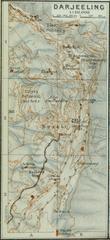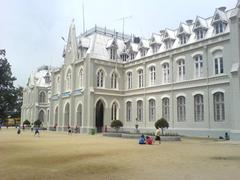
Comprehensive Guide to Visiting Darjeeling, Darjeeling Sadar Subdivision, India
Date: 13/08/2024
Captivating Introduction
Picture this: the sun’s first rays caressing the world’s third-highest peak, Mount Kanchenjunga, while the air is thick with the aroma of world-renowned tea. Welcome to Darjeeling, a town that feels like stepping into a living postcard. Located in the Darjeeling Sadar Subdivision of India, this gem of the Eastern Himalayas is more than just a scenic retreat—it’s a fascinating blend of history, culture, and adventure waiting to be explored.
Darjeeling is not just another tourist destination; it’s a melting pot of cultures and a historical treasure trove. From its early days as a vibrant hub for indigenous tribes like the Lepchas and Limbus (Discover Darjeeling), to its pivotal role in the ancient Silk Route trade (Wikipedia), every corner of Darjeeling whispers tales of its rich past. The British colonial era added another layer of charm, transforming this hill station into a summer retreat and tea paradise (Tale of 2 Backpackers).
But Darjeeling is not just about looking back; it’s about experiencing the present. Imagine strolling down Mall Road, feeling the colonial-era magic, or sipping a cup of Darjeeling tea at a local estate, where the unique climate and British agricultural know-how have created a brew worthy of global fame (Audiala). Whether you’re catching the sunrise at Tiger Hill or taking a ride on the UNESCO World Heritage Toy Train, Darjeeling offers a plethora of experiences that cater to all kinds of travelers.
Ready to dive deep into the enchanting allure of Darjeeling? This comprehensive guide will take you through its historical significance, cultural heritage, and modern-day attractions, ensuring you don’t miss out on any hidden gems. So, let’s embark on this journey through Darjeeling, where every moment is a story waiting to be told.
Table of Contents
- Historical Significance of Darjeeling
- Cultural Significance of Darjeeling
- Discover the Magic of Darjeeling: A Local’s Guide to Unforgettable Adventures
Historical Significance of Darjeeling, Darjeeling Sadar Subdivision, India
Early Indigenous Tribes and Settlements
Before the British arrived, Darjeeling was a vibrant hub for tribes like the Lepchas and the Limbus, who were experts in agriculture and animal husbandry. Influences from neighboring Tibet and Sikkim were strong, enriching the region’s cultural tapestry. Fun fact: ‘Darjeeling’ means ‘Land of the Thunderbolt’ in Tibetan—how cool is that? (Discover Darjeeling).
Role in the Silk Route Trade
Picture this: merchants trekking through Darjeeling, laden with treasures from Tibet, Nepal, Bhutan, and the Indian plains. This ancient Silk Route not only saw the exchange of goods but also of ideas, making Darjeeling a melting pot of cultures (Wikipedia).
British Colonial Era
Acquisition by the British East India Company
In 1829, a border spat between Nepal and Sikkim brought the British East India Company to Darjeeling. Captain George Alymer Lloyd and J.W. Grant saw its potential as a cool, scenic sanatorium. By 1835, the British had leased Darjeeling from Sikkim, setting the stage for its transformation (Tale of 2 Backpackers).
Establishment as a Hill Station
Darjeeling soon became a favorite summer retreat for British officials. Roads, schools, and hospitals sprang up, and the town’s colonial charm is still evident today. Ever walked down Mall Road and felt like you stepped back in time? It’s that colonial-era magic (Wikipedia).
Development of Tea Plantations
Here’s a ‘tea-riffic’ tidbit: the British planted the first tea gardens in the 1840s, and by the 1860s, Darjeeling tea was the talk of the town globally. With its unique climate and British agricultural know-how, Darjeeling tea achieved fame and even got a Geographical Indication (GI) status (Audiala).
Darjeeling Himalayan Railway
The charming ‘Toy Train’ chugged into existence in 1881, connecting Darjeeling to the plains and boosting its popularity as a tourist spot. Today, this UNESCO World Heritage Site remains a beloved icon of Darjeeling (Wikipedia).
Post-Independence Period
Integration into West Bengal
Post-1947, Darjeeling became part of West Bengal. The influx of Tibetan refugees after Tibet’s annexation in 1950 added another layer of cultural richness to Darjeeling (Wikipedia).
Gorkhaland Movement
The quest for Gorkhaland has been a major political issue. Led by groups like the GNLF and GJM, the movement seeks greater autonomy. While it has caused unrest, it also highlights Darjeeling’s unique cultural identity (Discover Darjeeling).
Cultural Heritage
Diverse Ethnic Tapestry
Darjeeling is a vibrant mosaic of Nepalis, Tibetans, Bengalis, and indigenous tribes. Festivals like Dashain, Tihar, Losar, and Christmas are celebrated with gusto, reflecting the region’s cultural harmony (Wikipedia).
Influence of Multiple Religions
Buddhism, Hinduism, Christianity, and Islam all thrive in Darjeeling. Visit Ghoom Monastery, the Japanese Peace Pagoda, or St. Andrew’s Church to see this spiritual diversity in action (Discover Darjeeling).
Modern-Day Darjeeling
Tourism and Economy
Tourism is the lifeblood of Darjeeling. From the Darjeeling Himalayan Railway to Tiger Hill and tea gardens, there’s something for everyone. Tea tourism is also a growing trend—you can even stay in colonial bungalows! (Darjeeling Travel).
Sustainable Tourism Initiatives
Darjeeling is going green! Initiatives like waste management, eco-friendly lodgings, and community-based tourism are taking root (Darjeeling Travel).
Visitor Tips
Best Time to Visit
Spring (March to May) and autumn (September to November) are ideal for clear skies and pleasant weather. Monsoon (June to August) has its own misty charm (Travel Triangle).
How to Get There
Bagdogra Airport is the nearest airport, about 70 km away. From there, taxis or shared jeeps can take you to Darjeeling. New Jalpaiguri is the closest major railway station (Jayanti Travels).
Accommodation Options
From budget guesthouses to luxury hotels, Darjeeling has it all. For a unique stay, try colonial-era bungalows or tea estate lodges. Popular areas include Chowrasta and Mall Road (Darjeeling Travel).
Local Cuisine
Don’t miss out on momos, thukpa, and churpee. And of course, savor some Darjeeling tea at local tea shops or estates (Darjeeling Travel).
By diving into its history and culture, you’ll appreciate Darjeeling’s enchanting allure. Whether it’s the colonial charm or the diverse cultural tapestry, Darjeeling has a story to tell. Ready to explore? Download the Audiala app for an immersive experience!
Cultural Significance of Darjeeling
A Melting Pot of Cultures
Darjeeling’s culture is a rich tapestry, woven from the diverse ethnic groups that have called this place home over centuries. The Lepchas, Bhutias, Sherpas, Yolmos, Gurungs, and Tamangs all contribute unique traditions and customs, creating a cosmopolitan atmosphere distinct from the rest of India. Imagine the intermingling of these cultures, resulting in hybrid traditions that make Darjeeling a true cultural mosaic (Wikipedia).
Festivals: A Year-Round Celebration
Darjeeling’s cultural calendar is jam-packed with festivals reflecting its multi-ethnic composition. Hinduism and Vajrayana Buddhism are predominant, and major festivals like Dashain, Tihar, Buddha Jayanti, Christmas, Holi, and Ram Navami light up the town. Local festivals like Losar (Tibetan New Year), Maghe Sankranti, Chotrul Duchen, and Tendong Lho Rumfaat are celebrated with gusto by the Buddhist ethnic groups (Wikipedia).
And don’t miss the Kirati festivals like Ubhauli Udhauli, Sakela, and Chasok Tangnam, where traditional songs like Deusi and Bhailo bring the streets to life (Wikipedia).
Savor the Flavors: Indigenous Cuisine
Darjeeling’s cuisine is like a warm hug on a cold day. Think less spicy, more heartwarming. Start your day with a mug of tea with milk, and don’t miss out on the butter tea made from compressed tea leaves, butter, water, milk, and salt. The staple diet, usually eaten twice a day, is cooked with little or no oil, embodying the region’s simple yet flavorful culinary traditions (Wikipedia).
Architectural Wonders
Stroll through Darjeeling and you’ll feel like you’ve stepped back in time. The colonial past is etched in its architecture—from charming cottages and Gothic churches to the Planters’ Club and Raj Bhawan. Don’t miss St. Andrew’s Church and various educational institutions showcasing colonial architectural styles, adding to the town’s aesthetic and historical charm (Wikipedia).
Hidden Gems and Must-Visit Spots
Tiger Hill
Catch the sunrise over the Himalayas from Tiger Hill, where you get panoramic views of Mount Everest and Mount Kanchenjunga. It’s a spot every traveler must experience, and it’s just 13 km from town (Travels of a Bookpacker).
Padmaja Naidu Himalayan Zoological Park
Home to the adorable red panda, this park is a haven for wildlife enthusiasts and conservationists (Wikipedia).
Monasteries
The Ghoom Monastery, one of the oldest in the region, is more than a place of worship—it’s a cultural hub preserving traditional arts and crafts (Wikipedia).
Tea Gardens
No trip to Darjeeling is complete without visiting a tea plantation. The Happy Valley Tea Estate offers tours that end with a tasting session, giving you a deep dive into the world of Darjeeling tea (Travels of a Bookpacker).
Sports and Recreation
Football reigns supreme here, with the annual Gold Cup tournament being a highlight. And if you see kids playing Chungi with a rubber band ball, don’t be shy—join in! Darjeeling also serves as a gateway for trekking and mountaineering expeditions in the Himalayas (Wikipedia).
Cultural Institutions
Himalayan Mountaineering Institute
Founded in 1954 to honor Tenzing Norgay, this institute is a must-visit for climbing enthusiasts and history buffs alike (Travels of a Bookpacker).
Tibetan Refugee Self Help Centre
A cultural and economic hub for Tibetan refugees, this center showcases exquisite Tibetan crafts like carpets, woodwork, and leatherwork (Wikipedia).
Pro Tips for Visitors
- Best Time to Visit: September to November and April to May offer the best weather for sightseeing and outdoor fun (Wikipedia).
- Getting Around: Reach Darjeeling via National Highway 110 from Siliguri, 77 km away. The nearest airport is Bagdogra Airport, 90 km from Darjeeling. Shared jeeps are a popular mode of transport within town (Wikipedia).
- Stay Options: From budget guesthouses to deluxe lodgings in old bungalows, there’s something for everyone. Just remember to book in advance during peak seasons (Travels of a Bookpacker).
- Local Etiquette: Respect local customs, dress modestly, and always ask before snapping photos of people or inside religious sites.
Conclusion: Your Darjeeling Adventure Awaits!
Darjeeling’s cultural significance is a delightful blend of diverse ethnic heritage, colonial history, and natural beauty. Whether you’re marveling at its architectural wonders, joining in local festivals, or savoring its unique cuisine, Darjeeling promises a rich and immersive cultural experience. Ready to explore? Let Audiala be your guide to the hidden gems and vibrant culture of this enchanting town!
Download the Audiala app now and start your Darjeeling adventure!
Discover the Magic of Darjeeling: A Local’s Guide to Unforgettable Adventures
Introduction
Picture this: The sun rising over the majestic Kanchenjunga, painting the sky in hues of pink and gold. Welcome to Darjeeling, the jewel of the Eastern Himalayas. Known for its breathtaking landscapes, rich cultural heritage, and world-famous tea, Darjeeling offers a unique blend of natural beauty and vibrant local life. This guide aims to provide you with an insider’s perspective on the best experiences this enchanting town has to offer.
Exploring the Town
Darjeeling is a town that invites exploration. Start your journey at the iconic Mall Road, where you can soak in panoramic views of the snow-capped Kanchenjunga range. Don’t miss the chance to visit the Darjeeling Himalayan Railway, a UNESCO World Heritage site, for a ride on the charming Toy Train. For a hidden gem, stroll to the Observatory Hill, where you can find the ancient Mahakal Temple and soak in the spiritual ambiance.
Tea Gardens
No trip to Darjeeling is complete without visiting its famous tea gardens. Take a tour of the Happy Valley Tea Estate, where you can learn about the intricate process of tea production and enjoy a tasting session. The lush green plantations provide a serene backdrop for a leisurely stroll. Pro tip: Visit the lesser-known Singtom Tea Estate for an off-the-beaten-path experience and sample their exclusive blends.
Cultural Experiences
Immerse yourself in the local culture by visiting the Himalayan Mountaineering Institute and the Padmaja Naidu Himalayan Zoological Park. These institutions offer a glimpse into the region’s mountaineering history and diverse wildlife. Additionally, explore the many monasteries, such as the Ghoom Monastery, to experience the spiritual side of Darjeeling. Don’t miss the vibrant local markets where you can buy handmade crafts and chat with friendly locals.
Adventure Activities
For the adventure enthusiasts, Darjeeling offers a range of activities. Go trekking in the Singalila National Park, known for its stunning vistas and diverse flora and fauna. Paragliding and river rafting are other popular options for those seeking an adrenaline rush. How about a challenge? Try to spot the rare red panda while trekking – it’s like a real-life treasure hunt!
Culinary Delights
Savor the flavors of Darjeeling by indulging in local cuisine. Try the delicious momos, thukpa, and traditional Nepali dishes at the many eateries scattered around town. Don’t forget to visit Glenary’s for a delightful array of pastries and baked goods. For a quirky twist, head to Keventers for a hot cup of cocoa with a view, or hunt down the best street-side chaat stall to tantalize your taste buds.
Conclusion
Darjeeling is a destination that promises unforgettable adventures and cherished memories. Whether you’re here for the scenic beauty, cultural experiences, or thrilling activities, this guide will help you make the most of your visit. So pack your bags, don your explorer’s hat, and get ready to discover the magic of Darjeeling!
Call to Action
Before you embark on your journey, don’t forget to download Audiala, the ultimate tour guide app, for expert insights and hidden gems. Let Audiala be your companion in uncovering the secrets of Darjeeling!
Call to Action
As your journey through Darjeeling comes to an end, you’ll find that this quaint hill station has left an indelible mark on your heart. From its rich historical tapestry woven by indigenous tribes, ancient traders, and British colonialists (Discover Darjeeling), to its vibrant cultural mosaic of festivals, cuisine, and architecture (Wikipedia), Darjeeling is a destination that offers a multi-sensory experience unlike any other.
Whether you were captivated by the serene beauty of its tea gardens, enchanted by the spiritual ambiance of its monasteries, or thrilled by its array of adventure activities, Darjeeling has something for everyone. The town’s commitment to sustainable tourism ensures that its natural beauty and cultural heritage are preserved for future generations to enjoy (Darjeeling Travel).
But what truly sets Darjeeling apart is its unique blend of the old and the new. The colonial charm is still palpable as you walk down Mall Road, while modern-day initiatives and eco-friendly practices are paving the way for a brighter future. Festivals like Dashain, Tihar, and Losar reflect the town’s diverse ethnic tapestry, making every visit a cultural celebration (Wikipedia).
So, pack your bags and get ready to explore the magic of Darjeeling. And remember, to truly unlock the secrets and stories of this enchanting town, download the Audiala app. It’s your perfect companion for an immersive experience, offering expert insights and highlighting hidden gems that only a local would know. Ready to make memories that will last a lifetime? Darjeeling awaits!
References
- Discover Darjeeling, n.d., https://discoverdarjeeling.com/history-of-darjeeling/
- Wikipedia, n.d., https://en.wikipedia.org/wiki/History_of_Darjeeling
- Tale of 2 Backpackers, n.d., https://taleof2backpackers.com/history-of-darjeeling/
- Audiala, n.d., https://audiala.com/en/india/darjeeling/
- Darjeeling Travel, n.d., https://darjeeling.travel/







